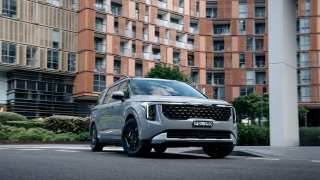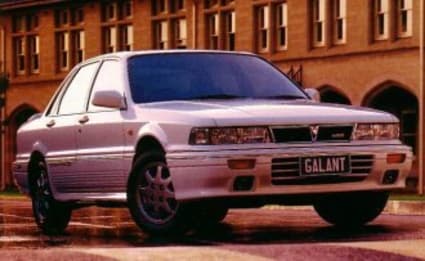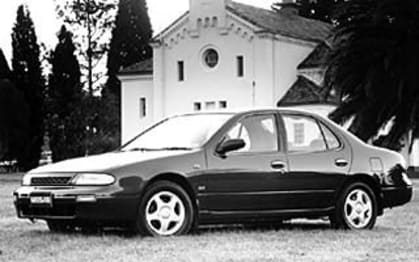
Used Mitsubishi Galant review: 1993-1996
- Mitsubishi Galant
- Mitsubishi Galant 1993
- Mitsubishi Galant 1994
- Mitsubishi Galant 1995
- Mitsubishi Galant 1996
- Mitsubishi Galant Reviews
- Mitsubishi Reviews
- Mitsubishi Hatchback Range
- Hatchback
- Mitsubishi
- Used Car Reviews
- Buying tips

There was a joke in the early 90s that if you removed the badges from the new cars in showrooms at the time no one could tell one from another the styling was so similar across the makes. The jibe was aimed primarily at Japanese carmakers that, it seemed, were working to a common styling formula when designing their cars.
The cars, the critics cried in unison, all looked as if they came from an upturned jelly mould with their rounded lines and generous curves, but anyone who cared to look under the skin would have found some of the most competent cars ever to roll out of an Australian showroom.
The HJ Mitsubishi Galant is a case in point. Its styling is inoffensive, even attractive in some eyes, but it could just as easily have had Ford, Mazda, Nissan, Honda or Toyota badges. Only the trained eye could tell one from another.
While the critics bemoaned the direction of styling at the time, owners of the Galant loved them. They were well equipped, well built, comfortable, smooth, and zippy. All of which makes them a car worth considering now as a second car for the family, or a safe and secure first car for the young driver.
MODEL WATCH
The mid-sized five-door HJ Galant arrived here in 1993. It was primarily aimed at empty nesters wanting to downsize once the kids had seen the light and found the door, and so-called dinks, the couples who’d dedicated their lives to their careers and hadn’t found the time or desire to procreate.
The Galant was a neat solution, roomy enough to carry two adults on a regular basis, or four when the need arose, and the rear hatch made it a flexible load carrier when heading home from the supermarket or away to the mountains on the weekend.
There were two engines on offer, both 2.0-litre in capacity. The base engine, a 2.0-litre overhead cam fuel-injected four was carried over from the previous model, but boasted improvements to the cylinder head that boosted its power and torque output. Peak power was 90 kW at 6000 revs and top torque was 170 Nm at 4250 revs.
The brand new optional V6, also 2.0 litres in capacity, boasted four valves per cylinder and a variable length intake system that contributed to its 110 kW power output at 6750 revs and it max torque of 179 Nm at 4000 revs.
On the road both engines had zippy performance and admirable fuel economy, although the four was rather harsh in comparison to the silky smooth V6. In performance terms there was very little between the two, which made the choice of the more expensive V6 a difficult one at the time, although it did have slightly better off-line zip than the four.
Both had a choice of five-speed manual gearbox and a four-speed auto, both of which were new. The manual was a smooth shifting unit with nicely spaced ratios, and the auto was well matched to the engine. Drive was through the front wheels.
When pressed the V6 auto would race to 100 km/h in 11.3 seconds, the slush-backed four in 11.6s. The times for the standing 400-metre dash were 18.0s and 18.3s respectively.
Under the smooth skin lay wishbone suspension, new to the model, and endowed the Galant with safe, predictable understeer, a blessing for all but enthusiast drivers wanting a more thrilling ride.
Inside the seats were quite comfortable and supportive, and the controls well laid-out.
Standard equipment on the four included adjustable steering column, power windows and mirrors, central locking, cruise control, air-conditioning, power steering, and a reasonable sound system, although the lack of a CD player means it’s outdated today. The six also had alloy wheels, a smart body kit, sports seats, and leather wrapped steering wheel.
ABS was standard on the V6 but not available on the four, and sadly there were no airbags on offer on either.
The four-cylinder model was dropped in 1994, but the V6 carried on until 1996 before the Galant badge disappeared from Mitsubishi showrooms.
IN THE SHOP
Like all modern cars it’s important to check for a service record, to verify the odometer reading and to confirm a regular service schedule. Regular servicing is a reliable pointer to a caring owner.
Mitsubishi recommend the cam-timing belt be changed at 100,000 km intervals so check to make sure that’s been done. If not you should ensure it’s done as soon as you buy the car, or make it a part of the purchase deal.
Mechanically there are no glaring concerns reported with the Galant, the engines and gearboxes are generally robust and reliable.
Check body for bumps and scrapes from traffic or parking mishaps, but the Galant body stands the test of time well. Doors close sweetly even after a decade on the road, but be careful to check the rear hatch to see that it opens and closes smoothly. Be suspicious of one that doesn’t, and look further for evidence of rear body damage.
Inside the trim stands up well, the seat fabrics show little wear on the high wear surfaces, and the plastic bits and pieces don’t appear prone to damage from the sun.
OWNER’S SAY
John Bugge followed his policy of buying two or three year old used cars with no more than 40,000 km on the odometer when he bought his 1993 Galant V6 eight years ago.
It has now done 150,000 km and has needed no time in the workshop apart from regular servicing, which Bugge has done with an almost religious fervour. The cam-timing belt was changed just before the 100,000 km recommended changeover. It is garaged and kept in pristine condition by an obviously proud owner.
Bugge was attracted to the Galant’s combination of styling, roominess for the two adults it had to accommodate, equipment level, and performance. He says it is the best car he has ever owned and would readily have another.
LOOK FOR:
• Inconspicuous styling
• good build quality
• roomy interior with flexibility of hatch
• reliable engines and transmissions
• Comfortable ride and secure handling
Pricing
| Year | Price From | Price To |
|---|---|---|
| 1996 | $4,290 | $6,710 |
| 1995 | $3,850 | $6,710 |
| 1994 | $3,740 | $6,600 |
| 1993 | $3,190 | $7,040 |
Pricing guides
Range and Specs
| Vehicle | Specs | Price* | |
|---|---|---|---|
| SE | 2.0L, ULP, 5 SP MAN | $3,410 – 5,280 | 1993 Mitsubishi Galant 1993 SE Pricing and Specs |
| GSR | 2.0L, ULP, 5 SP MAN | $4,290 – 6,380 | 1993 Mitsubishi Galant 1993 GSR Pricing and Specs |
| VR4 (4WS) | 2.0L, ULP, 5 SP MAN | $4,840 – 7,040 | 1993 Mitsubishi Galant 1993 VR4 (4WS) Pricing and Specs |
| V6-24 | 2.0L, ULP, 5 SP MAN | $4,070 – 5,940 | 1993 Mitsubishi Galant 1993 V6-24 Pricing and Specs |
Other cars to consider
$3,960
Lowest price, based on third party pricing data











